工具类,导入jar即可使用:
(FastJson有Jsonobject,Json,Jsonarray类,Jackson只有Objectmapper类)
private final static ObjectMapper objectMapper = new ObjectMapper();
private JacksonUtils() {
}
public static ObjectMapper getInstance() {
return objectMapper;
}
/**
* javaBean、列表数组转换为json字符串
*/
public static String obj2json(Object obj) throws Exception {
return objectMapper.writeValueAsString(obj);
}
/**
* javaBean、列表数组转换为json字符串,忽略空值
*/
public static String obj2jsonIgnoreNull(Object obj) throws Exception {
ObjectMapper mapper = new ObjectMapper();
mapper.setSerializationInclusion(JsonInclude.Include.NON_NULL);
return mapper.writeValueAsString(obj);
}
/**
* json 转JavaBean
*/
public static <T> T json2pojo(String jsonString, Class<T> clazz) throws Exception {
objectMapper.configure(DeserializationFeature.ACCEPT_SINGLE_VALUE_AS_ARRAY, true);
return objectMapper.readValue(jsonString, clazz);
}
/**
* json字符串转换为map
*/
public static <T> Map<String, Object> json2map(String jsonString) throws Exception {
ObjectMapper mapper = new ObjectMapper();
mapper.setSerializationInclusion(JsonInclude.Include.NON_NULL);
return mapper.readValue(jsonString, Map.class);
}
/**
* json字符串转换为map
*/
public static <T> Map<String, T> json2map(String jsonString, Class<T> clazz) throws Exception {
Map<String, Map<String, Object>> map = objectMapper.readValue(jsonString, new TypeReference<Map<String, T>>() {
});
Map<String, T> result = new HashMap<String, T>();
for (Map.Entry<String, Map<String, Object>> entry : map.entrySet()) {
result.put(entry.getKey(), map2pojo(entry.getValue(), clazz));
}
return result;
}
/**
* 深度转换json成map
*
* @param json
* @return
*/
public static Map<String, Object> json2mapDeeply(String json) throws Exception {
return json2MapRecursion(json, objectMapper);
}
/**
* 把json解析成list,如果list内部的元素存在jsonString,继续解析
*
* @param json
* @param mapper 解析工具
* @return
* @throws Exception
*/
private static List<Object> json2ListRecursion(String json, ObjectMapper mapper) throws Exception {
if (json == null) {
return null;
}
List<Object> list = mapper.readValue(json, List.class);
for (Object obj : list) {
if (obj != null && obj instanceof String) {
String str = (String) obj;
if (str.startsWith("[")) {
obj = json2ListRecursion(str, mapper);
} else if (obj.toString().startsWith("{")) {
obj = json2MapRecursion(str, mapper);
}
}
}
return list;
}
/**
* 把json解析成map,如果map内部的value存在jsonString,继续解析
*
* @param json
* @param mapper
* @return
* @throws Exception
*/
private static Map<String, Object> json2MapRecursion(String json, ObjectMapper mapper) throws Exception {
if (json == null) {
return null;
}
Map<String, Object> map = mapper.readValue(json, Map.class);
for (Map.Entry<String, Object> entry : map.entrySet()) {
Object obj = entry.getValue();
if (obj != null && obj instanceof String) {
String str = ((String) obj);
if (str.startsWith("[")) {
List<?> list = json2ListRecursion(str, mapper);
map.put(entry.getKey(), list);
} else if (str.startsWith("{")) {
Map<String, Object> mapRecursion = json2MapRecursion(str, mapper);
map.put(entry.getKey(), mapRecursion);
}
}
}
return map;
}
/**
* 与javaBean json数组字符串转换为列表
*/
public static <T> List<T> json2list(String jsonArrayStr, Class<T> clazz) throws Exception {
JavaType javaType = getCollectionType(ArrayList.class, clazz);
List<T> lst = (List<T>) objectMapper.readValue(jsonArrayStr, javaType);
return lst;
}
/**
* 获取泛型的Collection Type
*
* @param collectionClass 泛型的Collection
* @param elementClasses 元素类
* @return JavaType Java类型
* @since 1.0
*/
public static JavaType getCollectionType(Class<?> collectionClass, Class<?>... elementClasses) {
return objectMapper.getTypeFactory().constructParametricType(collectionClass, elementClasses);
}
/**
* map 转JavaBean
*/
public static <T> T map2pojo(Map map, Class<T> clazz) {
return objectMapper.convertValue(map, clazz);
}
/**
* map 转json
*
* @param map
* @return
*/
public static String mapToJson(Map map) {
try {
return objectMapper.writeValueAsString(map);
} catch (Exception e) {
e.printStackTrace();
}
return "";
}
/**
* map 转JavaBean
*/
public static <T> T obj2pojo(Object obj, Class<T> clazz) {
return objectMapper.convertValue(obj, clazz);
}
该博客主要讲3点:
1、统一时间格式可以使用注解
@JsonFormat也可以在spring配置文件中配置全局的格式
2、说了一些Jackson在Spring Boot框架中的配置项,我们应该如何配置3、讲了一些注解:序列化注解,反序列化注解,属性注解,常规注解,我们最常用到的是@JsonProperty注解和@JsonFormat注解
4、springboot中对加了@RestController或者@Controller+@ResponseBody注解的方法的返回值默认是Json格式,所以,对date类型的数据,在返回浏览器端时,会被springboot默认的Jackson框架转换,而Jackson框架默认的时区GMT(相对于中国是少了8小时)。所以最终返回到前端结果是相差8小时
解决办法:
1:只要在url后面加上&serverTimezone=GMT%2b8就完美解决
2:实体类的属性上添加注解@JsonFormat(pattern = "yyyy-MM-dd HH:mm:ss",timezone = "GMT+8")
Spring Boot框架中使用Jackson的处理总结
1.前言
通常我们在使用Spring Boot框架时,如果没有特别指定接口的序列化类型,则会使用Spring Boot框架默认集成的Jackson框架进行处理,通过Jackson框架将服务端响应的数据序列化成JSON格式的数据。
本文主要针对在Spring Boot框架中使用Jackson进行处理的经验进行总结,同时也结合在实际开发场景中碰到的问题以及解决方案进行陈述。
本文涉及到的源码地址:codeInAction: 代码实战集合,经验总结输出
PS:目前市面上针对JSON序列化的框架很多,比较出名的就是Jackson、Gson、FastJson。如果开发者对序列化框架没有特别的要求的情况下,个人建议是直接使用Spring Boot框架默认集成的Jackson,没有必要进行更换。
2.统一序列化时间格式
在我们的接口中,针对时间类型的字段序列化是最常见的需求之一,一般前后端开发人员会针对时间字段统一进行约束,这样有助于在编码开发时,统一编码规范。
在Spring Boot框架中,如果使用Jackson处理框架,并且没有任何配置的情况下,Jackson针对不同时间类型字段,序列化的格式也会不尽相同。
先来看一个简单示例,User.java实体类编码如下:
public class User {
private String name;
private Integer age;
private LocalDateTime birthday;
private Date studyDate;
private LocalDate workDate;
private Calendar firstWorkDate;
public static User buildOne(){
User user=new User();
LocalDateTime now=LocalDateTime.now();
user.setWorkDate(now.plusYears(25).toLocalDate());
user.setStudyDate(Date.from(now.plusYears(5).atZone(ZoneId.systemDefault()).toInstant()));
user.setName("姓名-"+RandomUtil.randomString(5));
user.setAge(RandomUtil.randomInt(0,100));
user.setBirthday(now);
user.setFirstWorkDate(Calendar.getInstance());
return user;
}
//getter and setter...
}
接口代码层也很简单,返回一个User的实体对象即可,代码如下:
@RestController
public class UserApplication {
@GetMapping("/queryOne")
public ResponseEntity<User> queryOne(){
return ResponseEntity.ok(User.buildOne());
}
}
如果我们对框架代码没有任何的配置,此时我们通过调用接口/queryOne,拿到的返回结果数据如下图:
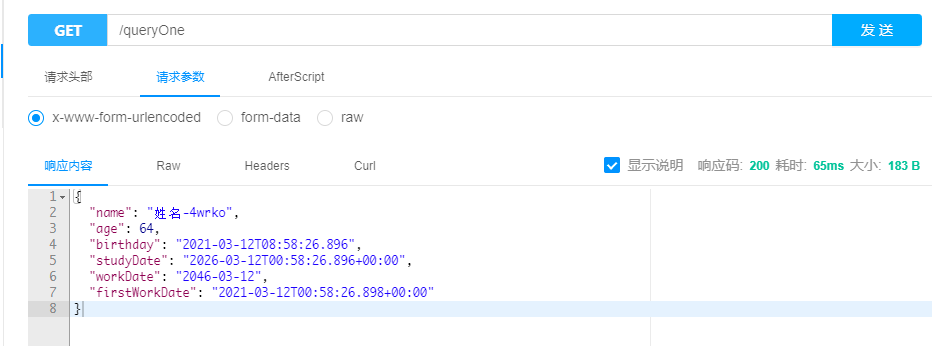
Jackson序列化框架针对四个不同的时间类型字段,序列化处理的操作是不同的,如果我们对时间字段有格式化的要求时,我们应该如何处理呢?
2.1 通过@JsonFormat注解
最直接也是最简单的一种方式,是我们通过使用Jackson提供的@JsonFormat注解,对需要格式化处理的时间字段进行标注,在@JsonFormat注解中写上我们的时间格式化字符,User.java代码如下:
public class User {
private String name;
private Integer age;
@JsonFormat(pattern = "yyyy-MM-dd HH:mm:ss")
private LocalDateTime birthday;
private Date studyDate;
private LocalDate workDate;
private Calendar firstWorkDate;
//getter and setter...
}
此时,我们再通过调用接口,拿到的返回结果如下图:
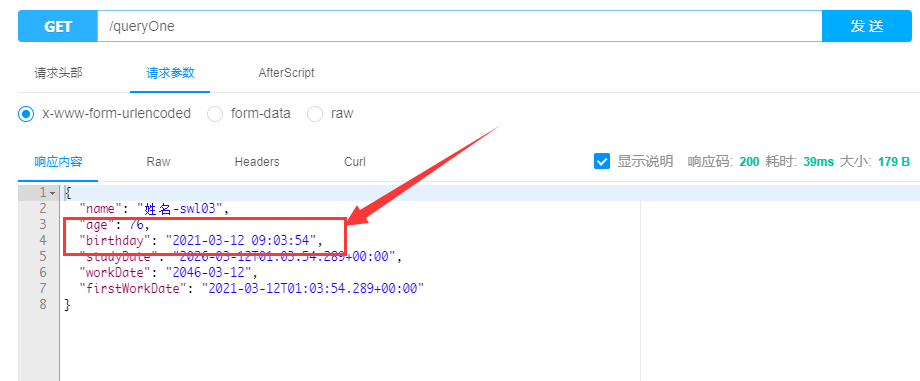
通过对birthday字段标注@JsonFormat注解,最终Jackson框架会将该字段序列化为我们标注的格式类型。
2.2 配置全局application.yml
通过@JsonFormat注解的方式虽然能解决问题,但是我们在实际的开发当中,涉及到的时间字段会非常多,如果全部都用注解的方式对项目中的时间字段进行标注,那开发的工作量也会很大,并且多团队一起协同编码时,难免会存在遗漏的情况,因此,@JsonFormat注解只适用于针对特定的接口,特定的场景下,对序列化响应的时间字段进行约束,而在全局的角度来看,开发者应该考虑通过在application.yml配置文件中进行全局配置
针对Spring Boot框架中Jackson的全局配置,我们在application.yml进行配置时,IDEA等编辑器会给出相应的提示,包含的属性如下图:

开发者可以通过org.springframework.boot.autoconfigure.jackson.JacksonProperties.java查看所有配置的源码信息
| 配置属性 | 说明 |
|---|---|
date-format | 日期字段格式化,例如:yyyy-MM-dd HH:mm:ss |
针对日期字段的格式化处理,我们只需要使用date-format属性进行配置即可,application.yml配置如下:
spring:
jackson:
date-format: yyyy-MM-dd HH:mm:ss
当然,如果有必要的话,还需要配置time-zone时区属性,不过该属性不配置的情况下,Jackson会使用系统默认时区。
我们从Spring Boot的源码中可以看到对Jackson的时间处理逻辑,JacksonAutoConfiguration.java中部分代码如下:
private void configureDateFormat(Jackson2ObjectMapperBuilder builder) {
// We support a fully qualified class name extending DateFormat or a date
// pattern string value
String dateFormat = this.jacksonProperties.getDateFormat();
if (dateFormat != null) {
try {
Class<?> dateFormatClass = ClassUtils.forName(dateFormat, null);
builder.dateFormat((DateFormat) BeanUtils.instantiateClass(dateFormatClass));
}
catch (ClassNotFoundException ex) {
SimpleDateFormat simpleDateFormat = new SimpleDateFormat(dateFormat);
// Since Jackson 2.6.3 we always need to set a TimeZone (see
// gh-4170). If none in our properties fallback to the Jackson's
// default
TimeZone timeZone = this.jacksonProperties.getTimeZone();
if (timeZone == null) {
timeZone = new ObjectMapper().getSerializationConfig().getTimeZone();
}
simpleDateFormat.setTimeZone(timeZone);
builder.dateFormat(simpleDateFormat);
}
}
}
从上面的代码中,我们可以看到的处理逻辑:
- 从yml配置文件中拿到
dateFormat属性字段 - 首先通过
ClassUtils.forName方法来判断开发者配置的是否是格式化类,如果配置的是格式化类,则直接配置dateFormat属性 - 类找不到的情况下,捕获
ClassNotFoundException异常,默认使用JDK自带的SimpleDateFormat类进行初始化
最终,我们在application.yml配置文件中配置了全局的Jackson针对日期处理的格式化信息,此时我们再看/queryOne接口响应的内容是什么情况呢?如下图:
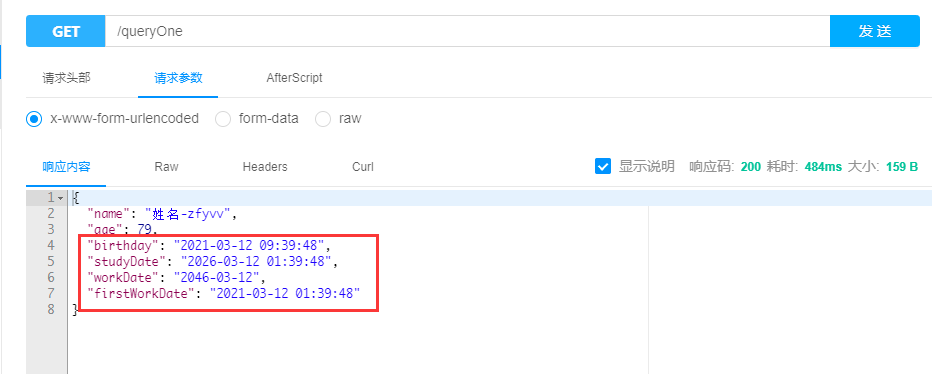
从图中我们可以发现,除了LocalDate类型的字段,包含时分秒类型的日期类型:LocalDateTime、Date、Calendar全部按照我们的要求将日期序列化成了yyyy-MM-dd HH:mm:ss格式,达到了我们的要求。
3.Jackson在Spring Boot框架中的配置选项
在上面的时间字段序列化处理,我们已经知道了如何配置,那么在Spring Boot的框架中,针对Jackson的各个配置项主要包含哪些呢?我们通过IDEA的提示可以看到,配置如下图:

在上面的12个属性中,每个属性的配置都会对Jackson产生不同的效果,接下来,我们逐一详解每个属性配置的作用
3.1 date-format日期格式化
date-format在前面我们已经知道了该属性的作用,主要是针对日期字段的格式化
3.2 time-zone时区
time-zone字段也是和日期字段类型,使用不同的时区,最终日期类型字段响应的结果会不一样
时区的表示方法有两种:
- 指定时区的名称,例如:
Asia/Shanghai,America/Los_Angeles - 通过格林威治平时
GMT针对时分秒做+或者-自定义操作
通过指定时区的名称,假设我们指定当前的项目是America/Los_Angeles,那么接口响应的数据是什么效果呢?
PS:时区名称如果不是很清楚的话,一般在Linux服务器的
/usr/share/zoneinfo目录可以进行查看,如下图:
application.yml:
spring:
jackson:
date-format: yyyy-MM-dd HH:mm:ss
time-zone: America/Los_Angeles
效果图如下:
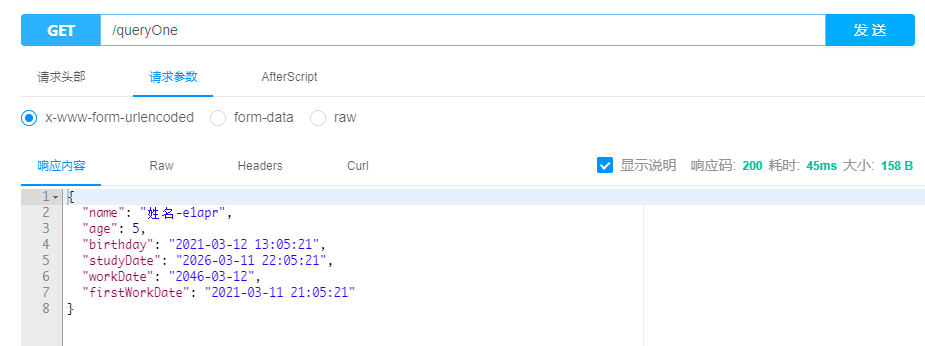
我们在结合代码来分析:
//User.java
public static User buildOne(){
User user=new User();
LocalDateTime now=LocalDateTime.now();
user.setWorkDate(now.plusYears(25).toLocalDate());
user.setStudyDate(Date.from(now.plusYears(5).atZone(ZoneId.systemDefault()).toInstant()));
user.setName("姓名-"+RandomUtil.randomString(5));
user.setAge(RandomUtil.randomInt(0,100));
user.setBirthday(now);
user.setFirstWorkDate(Calendar.getInstance());
return user;
}
由于洛杉矶时区与上海时区相差16个小时,因此,Jackson框架针对日期的序列化时,分别做了不同类型的处理,但我们也能看出差别
LocalDateTime、LocalDate类型的字段,Jackson的时区设置不会对该字段产生影响(因为这两个日期类型自带时区属性)Date、Calendar类型的字段受Jackson序列化框架的时区设置影响
另外一种方式是通过格林威治平时(GMT)做加减法,主要有两种格式支持:
GMT+HHMM或者GMT-HHMM或者GMT+H:其中HH代表的是小时数,MM代表的是分钟数,取值范围是0-9,例如我们常见的GMT+8代表东八区,也就是北京时间GMT+HH:MM或者GMT-HH:MM:其中HH代表的是小时数,MM代表的是分钟数,取值范围是0-9,和上面意思差不多
可以自己写测试代码进行测试,示例如下:
public class TimeTest {
public static void main(String[] args) {
LocalDateTime localDateTime=LocalDateTime.now();
DateTimeFormatter dateTimeFormatter=DateTimeFormatter.ofPattern("yyyy-MM-dd HH:mm:ss");
System.out.println(localDateTime.format(dateTimeFormatter));
System.out.println(LocalDateTime.now(ZoneId.of("GMT+0901")).format(dateTimeFormatter));
System.out.println(LocalDateTime.now(ZoneId.of("GMT+09:01")).format(dateTimeFormatter));
}
}
3.3 locale本地化
JSON序列化时Locale的变量设置
3.4 visibility访问级别
Jackson支持从私有字段中读取值,但是默认情况下不这样做,如果我们的项目中存在不同的序列化反序列化需求,那么我们可以在配置文件中对visibility进行配置
我们将上面User.java代码中的name属性的get方法修饰符从public变更为private,其他字段保持不变
代码如下:
public class User {
private String name;
private Integer age;
private Date nowDate;
private LocalDateTime birthday;
private Date studyDate;
private LocalDate workDate;
private Calendar firstWorkDate;
//getter方法修饰符从public修改为private
private String getName() {
return name;
}
//other setter and getter
}
此时,我们通过调用/queryOne接口响应结果如下:
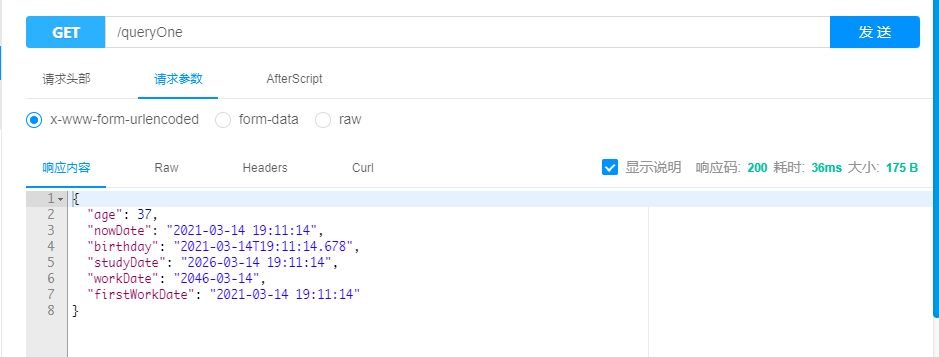
从结果中我们可以看到,由于我们将name属性的getter方法设置为了private,因此jackson在序列化时,没有拿到该字段
此时,我们再修改application.yml的配置,如下:
spring:
jackson:
visibility:
getter: any
我们通过将getter设置为any级别的类型,再调用/queryOne接口,响应结果如下:
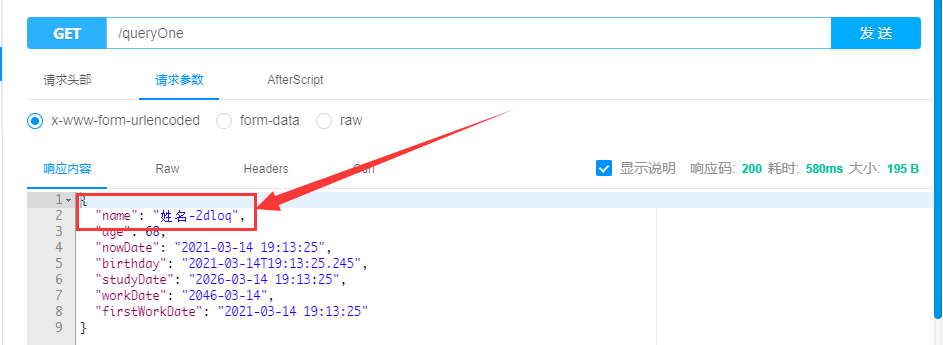
从图中可以看出,jackson序列化结果中又出现了name属性,这代表即使name字段的属性和getter方法都是private,但是jackson还是获取到了该成员变量的值,并且进行了序列化处理。
通过设置visibility属性即可达到上面的效果。开发者根据自己的需要自行进行选择。
3.5 property-naming-strategy属性命名策略
通常比较常见的我们针对java代码中的实体类属性一般都是驼峰命名法(Camel-Case),但是Jackson序列化框架也提供了更多的序列化策略,而property-naming-strategy就是配置该属性的。
先来看Spring Boot框架如何配置jackson的命名策略
JacksonAutoConfiguration.java
private void configurePropertyNamingStrategyField(Jackson2ObjectMapperBuilder builder, String fieldName) {
// Find the field (this way we automatically support new constants
// that may be added by Jackson in the future)
Field field = ReflectionUtils.findField(PropertyNamingStrategy.class, fieldName,
PropertyNamingStrategy.class);
Assert.notNull(field, () -> "Constant named '" + fieldName + "' not found on "
+ PropertyNamingStrategy.class.getName());
try {
builder.propertyNamingStrategy((PropertyNamingStrategy) field.get(null));
}
catch (Exception ex) {
throw new IllegalStateException(ex);
}
}
通过反射,直接获取PropertyNamingStrategy类中的成员变量的值
PropertyNamingStrategy定义了Jackson(2.11.4)框架中的命名策略常量成员变量
package com.fasterxml.jackson.databind;
//other import
public class PropertyNamingStrategy // NOTE: was abstract until 2.7
implements java.io.Serializable
{
/**
* Naming convention used in languages like C, where words are in lower-case
* letters, separated by underscores.
* See {@link SnakeCaseStrategy} for details.
*
* @since 2.7 (was formerly called {@link #CAMEL_CASE_TO_LOWER_CASE_WITH_UNDERSCORES})
*/
public static final PropertyNamingStrategy SNAKE_CASE = new SnakeCaseStrategy();
/**
* Naming convention used in languages like Pascal, where words are capitalized
* and no separator is used between words.
* See {@link PascalCaseStrategy} for details.
*
* @since 2.7 (was formerly called {@link #PASCAL_CASE_TO_CAMEL_CASE})
*/
public static final PropertyNamingStrategy UPPER_CAMEL_CASE = new UpperCamelCaseStrategy();
/**
* Naming convention used in Java, where words other than first are capitalized
* and no separator is used between words. Since this is the native Java naming convention,
* naming strategy will not do any transformation between names in data (JSON) and
* POJOS.
*
* @since 2.7 (was formerly called {@link #PASCAL_CASE_TO_CAMEL_CASE})
*/
public static final PropertyNamingStrategy LOWER_CAMEL_CASE = new PropertyNamingStrategy();
/**
* Naming convention in which all words of the logical name are in lower case, and
* no separator is used between words.
* See {@link LowerCaseStrategy} for details.
*
* @since 2.4
*/
public static final PropertyNamingStrategy LOWER_CASE = new LowerCaseStrategy();
/**
* Naming convention used in languages like Lisp, where words are in lower-case
* letters, separated by hyphens.
* See {@link KebabCaseStrategy} for details.
*
* @since 2.7
*/
public static final PropertyNamingStrategy KEBAB_CASE = new KebabCaseStrategy();
/**
* Naming convention widely used as configuration properties name, where words are in
* lower-case letters, separated by dots.
* See {@link LowerDotCaseStrategy} for details.
*
* @since 2.10
*/
public static final PropertyNamingStrategy LOWER_DOT_CASE = new LowerDotCaseStrategy();
//others...
}
从源码中我们可以看到,有六种策略供我们进行配置,配置示例如下:
spring:
jackson:
date-format: yyyy-MM-dd HH:mm:ss
locale: zh_CN
time-zone: GMT+8
visibility:
getter: any
property-naming-strategy: LOWER_CAMEL_CASE
SNAKE_CASE
SNAKE_CASE主要包含的规则,详见SnakeCaseStrategy:
- java属性名称中所有大写的字符都会转换为两个字符,下划线和该字符的小写形式,例如
userName会转换为user_name,对于连续性的大写字符,近第一个进行下划线转换,后面的大小字符则是小写,例如theWWW会转换为the_www - 对于首字母大写的情况,近转成小写,例如:
Results会转换为results,并不会转换为_results - 针对属性中已经包含下划线的情况,仅做小写转换处理
- 下划线出现在首位的情况下,会被去除处理,例如属性名:
_user会被转换为user
真实效果如下图:

UPPER_CAMEL_CASE
UPPER_CAMEL_CASE顾名思义,驼峰命名法的规则,只是首字母会转换为大写,详见UpperCamelCaseStrategy
真实效果图如下:

LOWER_CAMEL_CASE
LOWER_CAMEL_CASE效果和UPPER_CAMEL_CASE正好相反,其首字母会变成小写,详见LowerCamelCaseStrategy
效果图如下:
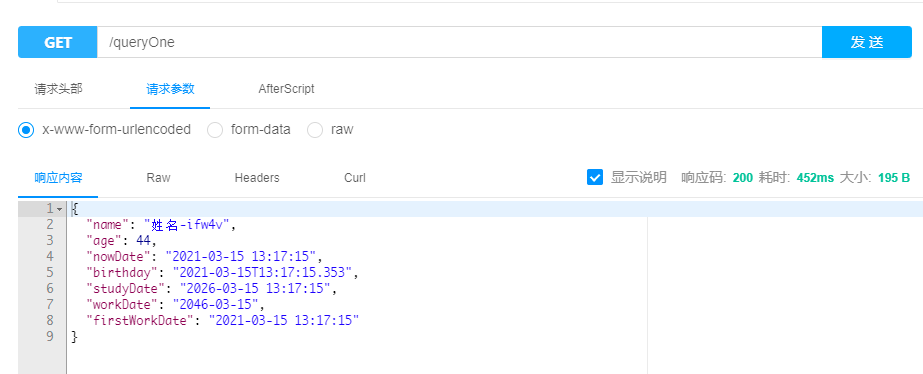
LOWER_CASE
LOWER_CASE从命名来看很明显,将属性名 全部转为小写,详见LowerCaseStrategy
KEBAB_CASE
KEBAB_CASE策略和SNAKE_CASE规则类似,只是下划线变成了横线-,详见KebabCaseStrategy
效果图如下:
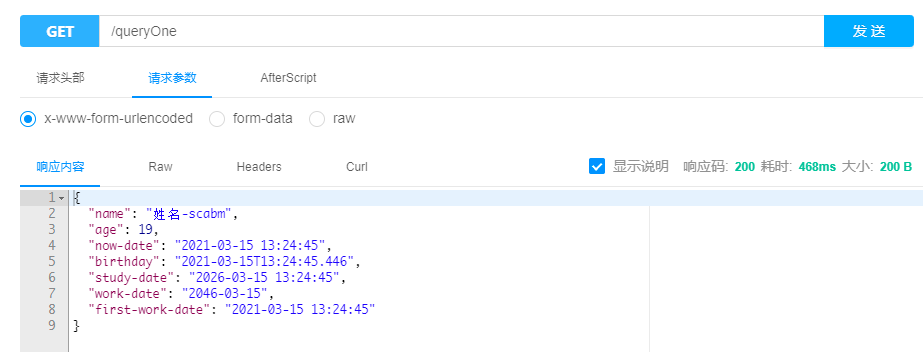
LOWER_DOT_CASE
LOWER_DOT_CASE策略和KEBAB_CASE规则相似,只是由横线变成了点.,详见LowerDotCaseStrategy
效果图如下:
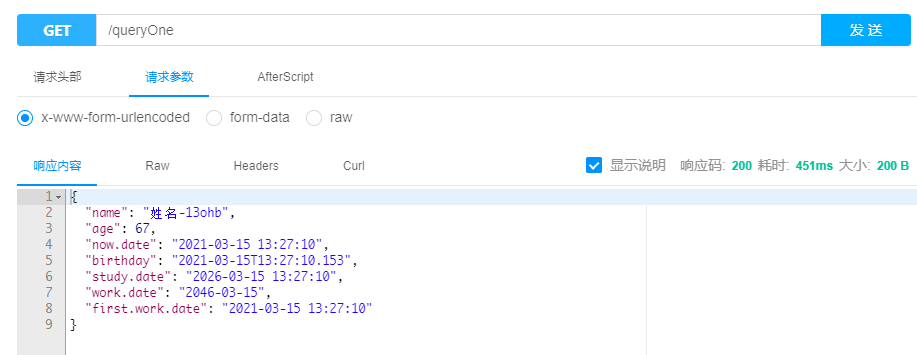
总结:看了上面这么多属性名称的策略,其实每一种类型只是不同的场景下才需要,如果上面jackson给定的默认策略名称无法满足,我们从源码中也能看到,通过自定义实现类,也能满足企业的个性化需求,非常方便。
3.6 mapper通用功能开关配置
mapper属性是一个Map类型,主要是针对MapperFeature定义开关属性,是否启用这些特性
/**
* Jackson general purpose on/off features.
*/
private final Map<MapperFeature, Boolean> mapper = new EnumMap<>(MapperFeature.class);
在MapperFeature.java中,我们可以跟踪源码来看:
/**
* Enumeration that defines simple on/off features to set
* for {@link ObjectMapper}, and accessible (but not changeable)
* via {@link ObjectReader} and {@link ObjectWriter} (as well as
* through various convenience methods through context objects).
*<p>
* Note that in addition to being only mutable via {@link ObjectMapper},
* changes only take effect when done <b>before any serialization or
* deserialization</b> calls -- that is, caller must follow
* "configure-then-use" pattern.
*/
public enum MapperFeature implements ConfigFeature
{
//.......
}
MapperFeature是一个枚举类型,对当前jackson的一些特性通过枚举变量的方式来定义开关属性,也是方便使用者来使用的。
主要包含以下枚举变量:
USE_ANNOTATIONS:USE_GETTERS_AS_SETTERSPROPAGATE_TRANSIENT_MARKERAUTO_DETECT_CREATORSAUTO_DETECT_FIELDSAUTO_DETECT_GETTERSAUTO_DETECT_IS_GETTERSAUTO_DETECT_SETTERSREQUIRE_SETTERS_FOR_GETTERSALLOW_FINAL_FIELDS_AS_MUTATORSINFER_PROPERTY_MUTATORSINFER_CREATOR_FROM_CONSTRUCTOR_PROPERTIESCAN_OVERRIDE_ACCESS_MODIFIERSOVERRIDE_PUBLIC_ACCESS_MODIFIERSUSE_STATIC_TYPINGUSE_BASE_TYPE_AS_DEFAULT_IMPLDEFAULT_VIEW_INCLUSIONSORT_PROPERTIES_ALPHABETICALLYACCEPT_CASE_INSENSITIVE_PROPERTIESACCEPT_CASE_INSENSITIVE_ENUMSACCEPT_CASE_INSENSITIVE_VALUESUSE_WRAPPER_NAME_AS_PROPERTY_NAMEUSE_STD_BEAN_NAMINGALLOW_EXPLICIT_PROPERTY_RENAMINGALLOW_COERCION_OF_SCALARSIGNORE_DUPLICATE_MODULE_REGISTRATIONSIGNORE_MERGE_FOR_UNMERGEABLEBLOCK_UNSAFE_POLYMORPHIC_BASE_TYPES
3.7 serialization序列化特性开关配置
serialization属性同mapper类似,也是一个Map类型的属性
/**
* Jackson on/off features that affect the way Java objects are serialized.
*/
private final Map<SerializationFeature, Boolean> serialization = new EnumMap<>(SerializationFeature.class);
3.8 deserialization反序列化开关配置
deserialization反序列化配置
/**
* Jackson on/off features that affect the way Java objects are deserialized.
*/
private final Map<DeserializationFeature, Boolean> deserialization = new EnumMap<>(DeserializationFeature.class);
3.9 parser配置
3.10 generator配置
3.11 defaultPropertyInclusion序列化包含的属性配置
该属性是一个枚举配置,主要包含:
ALWAYS:顾名思义,始终包含,和属性的值无关NON_NULL:值非空的属性才会包含属性NON_ABSENT:值非空的属性,或者Optional类型的属性非空NON_EMPTY: 空值的属性不包含NON_DEFAULT:不使用jackson的默认规则对该字段进行序列化,详见示例CUSTOM:自定义规则USE_DEFAULTS:配置使用该规则的属性字段,将会优先使用class上的注解规则,否则会使用全局的序列化规则,详见示例
CUSTOM自定义规则是需要开发者在属性字段上使用@JsonInclude注解,并且指定valueFilter属性,该属性需要传递一个Class,示例如下:
//User.java
//指定value级别是CUSTOM
@JsonInclude(value = JsonInclude.Include.CUSTOM, valueFilter = StringFilter.class)
private String name;
StringFilter则是判断非空的依据,该依据由开发者自己定义,返回true将会被排除,false则不会排除,示例如下:
//自定义非空判断规则
public class StringFilter {
@Override
public boolean equals(Object other) {
if (other == null) {
// Filter null's.
return true;
}
// Filter "custom_string".
return "custom_string".equals(other);
}
}
4.Spring Boot针对Jackson的约定配置做的事情
在前面的文章中,我们已经详细的了解了Jackson在Spring Boot框架中的各个配置项,那么Spring Boot针对Jackson框架在约定配置时会做哪些事情呢?
在Spring Boot的spring-boot-autoconfigure-x.x.jar包中,我们可以看到Spring Boot框架针对jackson的处理源码,如下图:
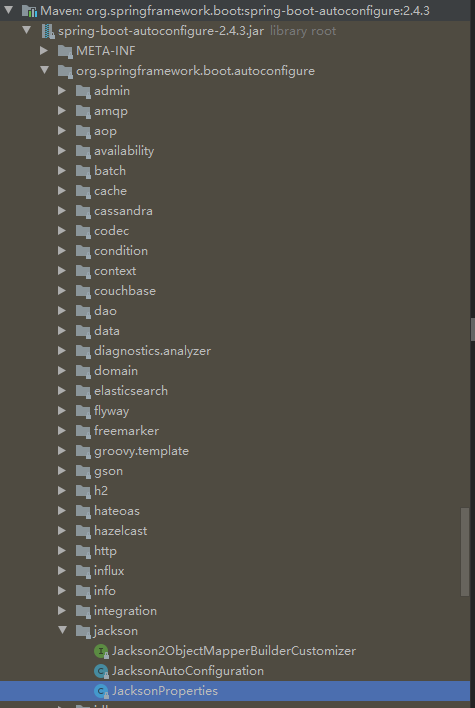
主要包含三个类:
- JacksonProperties:Spring Boot框架提供jackson的配置属性类,即开发者在
application.yml配置文件中的配置项属性 - JacksonAutoConfiguration:Jackson的默认注入配置类
- Jackson2ObjectMapperBuilderCustomizer:自定义用于注入jackson的配置辅助接口
核心类是JacksonAutoConfiguration.java,该类是Spring Boot框架将Jackson相关实体Bean注入Spring容器的关键配置类。其主要作用:
- 注入Jackson的
ObjectMapper实体Bean到Spring容器中 - 注入
ParameterNamesModule实体Bean到Spring容器中 - 注入
Jackson2ObjectMapperBuilder实体Bean - 注入
JsonComponentModule实体Bean - 注入
StandardJackson2ObjectMapperBuilderCustomizer实体Bean,该类是上面Jackson2ObjectMapperBuilderCustomizer的实现类,主要用于接收JacksonProperties属性,将Jackson的外部配置属性接收,然后最终执行customize方法,构建ObjectMapper所需要的Jackson2ObjectMapperBuilder属性,最终为ObjectMapper属性赋值准备
源码如下:
@Configuration(proxyBeanMethods = false)
@ConditionalOnClass(ObjectMapper.class)
public class JacksonAutoConfiguration {
private static final Map<?, Boolean> FEATURE_DEFAULTS;
static {
Map<Object, Boolean> featureDefaults = new HashMap<>();
featureDefaults.put(SerializationFeature.WRITE_DATES_AS_TIMESTAMPS, false);
featureDefaults.put(SerializationFeature.WRITE_DURATIONS_AS_TIMESTAMPS, false);
FEATURE_DEFAULTS = Collections.unmodifiableMap(featureDefaults);
}
@Bean
public JsonComponentModule jsonComponentModule() {
return new JsonComponentModule();
}
@Configuration(proxyBeanMethods = false)
@ConditionalOnClass(Jackson2ObjectMapperBuilder.class)
static class JacksonObjectMapperConfiguration {
@Bean
@Primary
@ConditionalOnMissingBean
ObjectMapper jacksonObjectMapper(Jackson2ObjectMapperBuilder builder) {
return builder.createXmlMapper(false).build();
}
}
@Configuration(proxyBeanMethods = false)
@ConditionalOnClass(ParameterNamesModule.class)
static class ParameterNamesModuleConfiguration {
@Bean
@ConditionalOnMissingBean
ParameterNamesModule parameterNamesModule() {
return new ParameterNamesModule(JsonCreator.Mode.DEFAULT);
}
}
@Configuration(proxyBeanMethods = false)
@ConditionalOnClass(Jackson2ObjectMapperBuilder.class)
static class JacksonObjectMapperBuilderConfiguration {
@Bean
@Scope("prototype")
@ConditionalOnMissingBean
Jackson2ObjectMapperBuilder jacksonObjectMapperBuilder(ApplicationContext applicationContext,
List<Jackson2ObjectMapperBuilderCustomizer> customizers) {
Jackson2ObjectMapperBuilder builder = new Jackson2ObjectMapperBuilder();
builder.applicationContext(applicationContext);
customize(builder, customizers);
return builder;
}
private void customize(Jackson2ObjectMapperBuilder builder,
List<Jackson2ObjectMapperBuilderCustomizer> customizers) {
for (Jackson2ObjectMapperBuilderCustomizer customizer : customizers) {
customizer.customize(builder);
}
}
}
@Configuration(proxyBeanMethods = false)
@ConditionalOnClass(Jackson2ObjectMapperBuilder.class)
@EnableConfigurationProperties(JacksonProperties.class)
static class Jackson2ObjectMapperBuilderCustomizerConfiguration {
@Bean
StandardJackson2ObjectMapperBuilderCustomizer standardJacksonObjectMapperBuilderCustomizer(
ApplicationContext applicationContext, JacksonProperties jacksonProperties) {
return new StandardJackson2ObjectMapperBuilderCustomizer(applicationContext, jacksonProperties);
}
static final class StandardJackson2ObjectMapperBuilderCustomizer
implements Jackson2ObjectMapperBuilderCustomizer, Ordered {
private final ApplicationContext applicationContext;
private final JacksonProperties jacksonProperties;
StandardJackson2ObjectMapperBuilderCustomizer(ApplicationContext applicationContext,
JacksonProperties jacksonProperties) {
this.applicationContext = applicationContext;
this.jacksonProperties = jacksonProperties;
}
@Override
public int getOrder() {
return 0;
}
@Override
public void customize(Jackson2ObjectMapperBuilder builder) {
if (this.jacksonProperties.getDefaultPropertyInclusion() != null) {
builder.serializationInclusion(this.jacksonProperties.getDefaultPropertyInclusion());
}
if (this.jacksonProperties.getTimeZone() != null) {
builder.timeZone(this.jacksonProperties.getTimeZone());
}
configureFeatures(builder, FEATURE_DEFAULTS);
configureVisibility(builder, this.jacksonProperties.getVisibility());
configureFeatures(builder, this.jacksonProperties.getDeserialization());
configureFeatures(builder, this.jacksonProperties.getSerialization());
configureFeatures(builder, this.jacksonProperties.getMapper());
configureFeatures(builder, this.jacksonProperties.getParser());
configureFeatures(builder, this.jacksonProperties.getGenerator());
configureDateFormat(builder);
configurePropertyNamingStrategy(builder);
configureModules(builder);
configureLocale(builder);
}
//more configure methods...
}
}
总结:通过一系列的方法,最终构造一个生产级别可用的ObjectMapper对象,供在Spring Boot框架中对Java对象实现序列化与反序列化操作。
5.Jackson常见注解使用示例
备注:本小结内容来源https://www.baeldung.com/jackson-annotations,如果工作中对于jackson的注解使用较少的情况下,可以看看该篇文章,是一个非常好的补充。
5.1 序列化
5.1.1 @JsonAnyGetter
@JsonAnyGetter注解运行可以灵活的使用Map类型的作为属性字段
实体类如下:
public class ExtendableBean {
public String name;
private Map<String, String> properties;
@JsonAnyGetter
public Map<String, String> getProperties() {
return properties;
}
public ExtendableBean(String name) {
this.name = name;
this.properties=new HashMap<String, String>();
}
public void add(String key,String value){
this.properties.put(key,value);
}
}
通过序列化该实体Bean,我们将会得到Map属性中的所有Key作为属性值,测试序列化代码如下:
@Test
public void whenSerializingUsingJsonAnyGetter_thenCorrect()
throws JsonProcessingException {
ExtendableBean bean = new ExtendableBean("My bean");
bean.add("attr1", "val1");
bean.add("attr2", "val2");
String result = new ObjectMapper().writeValueAsString(bean);
assertThat(result, containsString("attr1"));
assertThat(result, containsString("val1"));
}
最终输出结果如下:
{
"name":"My bean",
"attr2":"val2",
"attr1":"val1"
}
如果不使用@JsonAnyGetter注解,那么最终序列化结果将会在properties属性下面,结果如下:
{
"name": "My bean",
"properties": {
"attr2": "val2",
"attr1": "val1"
}
}
5.1.2 @JsonGetter
@JsonGetter注解是一个替代@JsonProperty的注解,可以将一个方法标注为getter方法
例如下面的示例中,我们通过注解@JsonGetter将方法getTheName()作为属性name的getter方法
public class MyBean {
public int id;
private String name;
@JsonGetter("name")
public String getTheName() {
return name;
}
}
5.1.3 @JsonPropertyOrder
可以通过使用@JsonPropertyOrder注解来指定属性的序列化顺序
实体bean定义如下:
@JsonPropertyOrder({ "name", "id" })
public class MyBean {
public int id;
public String name;
}
最终序列化结果为:
{
"name":"My bean",
"id":1
}
也可以通过@JsonPropertyOrder(alphabetic=true)来指定按照字母排序,那么响应结果将是:
{
"id":1,
"name":"My bean"
}
5.1.4 @JsonRawValue
@JsonRawValue注解可以指定字符串属性类为json,如下代码:
public class RawBean {
public String name;
@JsonRawValue
public String json;
}
创建RawBean的示例,给属性json赋值,代码如下:
RawBean bean = new RawBean("My bean", "{"attr":false}");
String result = new ObjectMapper().writeValueAsString(bean);
最终序列化结果如下:
{
"name":"My bean",
"json":{
"attr":false
}
}
5.1.5 @JsonValue
@JsonValue注解主要用于序列化整个实例对象的单个方法,例如,在一个枚举类中,@JsonValue注解进行标注,代码如下:
public enum TypeEnumWithValue {
TYPE1(1, "Type A"), TYPE2(2, "Type 2");
private Integer id;
private String name;
TypeEnumWithValue(Integer id, String name) {
this.id = id;
this.name = name;
}
@JsonValue
public String getName() {
return name;
}
}
测试代码如下:
String enumAsString = new ObjectMapper()
.writeValueAsString(TypeEnumWithValue.TYPE1);
System.out.println(enumAsString);
最终通过序列化代码得到的结果将是:
"Type A"
5.1.6 @JsonRootName
@JsonRootName注解旨在给当前序列化的实体对象加一层包裹对象。
举例如下:
//RootUser.java
public class RootUser {
private String name;
private String title;
public RootUser(String name, String title) {
this.name = name;
this.title = title;
}
//getter and setters
}
在上面的实体类中,正常情况下,如果要序列号RootUser对象,其结果格式为:
{
"name": "name1",
"title": "title1"
}
在RootUser加上@JsonRootName注解后,该类改动如下:
//RootUser.java
@JsonRootName(value = "root")
public class RootUser {
private String name;
private String title;
public RootUser(String name, String title) {
this.name = name;
this.title = title;
}
//getter and setters
}
启用ObjectMapper对象的WRAP_ROOT_VALUE特性,测试代码如下:
ObjectMapper objectMapper=new ObjectMapper();
objectMapper.enable(SerializationFeature.WRAP_ROOT_VALUE);
String result=objectMapper.writeValueAsString(new RootUser("name1","title1"));
最终序列化JSON结果如下:
{
"root": {
"name": "name1",
"title": "title1"
}
}
5.1.7 @JsonSerialize
@JsonSerialize注解允许开发者自定义序列化实现,来看代码实现
public class EventWithSerializer {
public String name;
@JsonSerialize(using = CustomDateSerializer.class)
public Date eventDate;
public Date publishDate;
//getter and setter...
}
在上面的代码中,针对eventDate字段,我们通过使用@JsonSerialize注解,自定义了一个序列化实现类CustomDateSerializer,该类实现如下:
//CustomDateSerializer.java
public class CustomDateSerializer extends StdSerializer<Date> {
private static SimpleDateFormat formatter
= new SimpleDateFormat("dd-MM-yyyy hh:mm:ss");
public CustomDateSerializer() {
this(null);
}
public CustomDateSerializer(Class<Date> t) {
super(t);
}
@Override
public void serialize(
Date value, JsonGenerator gen, SerializerProvider arg2)
throws IOException, JsonProcessingException {
gen.writeString(formatter.format(value));
}
}
最终序列化的结果格式如下:
{
"name": "名称",
"eventDate": "24-03-2021 06:14:32",
"publishDate": 1616580872574
}
从结果我们可以得知,针对某个特定的字段序列化的方式,我们可以完全自定义,非常的方便。
5.2 反序列化
5.2.1 @JsonCreator
@JsonCreator配合@JsonProperty注解能到达在反序列化实体对象时,指定不变更属性名称的效果
例如有如下JSON:
{
"id":1,
"theName":"My bean"
}
在实体类中,我们没有属性名称是theName,但我们想把theName属性反序列化时赋值给name,此时实体类对象结构如下:
public class BeanWithCreator {
public int id;
public String name;
@JsonCreator
public BeanWithCreator(
@JsonProperty("id") int id,
@JsonProperty("theName") String name) {
this.id = id;
this.name = name;
}
}
在BeanWithCreator的构造函数中添加@JsonCreator注解,并且配合@JsonProperty注解进行属性指向,最终反序列化代码如下:
@Test
public void whenDeserializingUsingJsonCreator_thenCorrect()
throws IOException {
String json = "{"id":1,"theName":"My bean"}";
BeanWithCreator bean = new ObjectMapper()
.readerFor(BeanWithCreator.class)
.readValue(json);
assertEquals("My bean", bean.name);
}
5.2.2 @JacksonInject
@JacksonInject注解可以指定反序列化对象时,属性值不从来源JSON获取,而从injection中获取
实体类如下:
public class BeanWithInject {
@JacksonInject
public int id;
public String name;
}
反序列化代码
@Test
public void whenDeserializingUsingJsonInject_thenCorrect()
throws IOException {
String json = "{"name":"My bean"}";
InjectableValues inject = new InjectableValues.Std()
.addValue(int.class, 1);
BeanWithInject bean = new ObjectMapper().reader(inject)
.forType(BeanWithInject.class)
.readValue(json);
assertEquals("My bean", bean.name);
assertEquals(1, bean.id);
}
5.2.3 @JsonAnySetter
@JsonAnySetter和@JsonAnyGetter注解意思一致,只不过是针对序列化与反序列化而言,@JsonAnySetter注解可以将来源JSON最终转化为Map类型的属性结构
实体代码如下:
public class ExtendableBean {
public String name;
private Map<String, String> properties;
@JsonAnySetter
public void add(String key, String value) {
properties.put(key, value);
}
}
JSON源如下:
{
"name":"My bean",
"attr2":"val2",
"attr1":"val1"
}
通过@JsonAnySetter的注解标注,最终attr1及attr2的值将会添加到properties的Map对象中
示例代码如下:
@Test
public void whenDeserializingUsingJsonAnySetter_thenCorrect()
throws IOException {
String json
= "{"name":"My bean","attr2":"val2","attr1":"val1"}";
ExtendableBean bean = new ObjectMapper()
.readerFor(ExtendableBean.class)
.readValue(json);
assertEquals("My bean", bean.name);
assertEquals("val2", bean.getProperties().get("attr2"));
}
5.2.4 @JsonSetter
@JsonSetter注解是@JsonProperty的替代注解,用于标注该方法为setter方法
当我们需要读取一些JSON数据时,但是目标实体类与该数据不完全匹配是,该注解是非常有用的。
示例代码如下:
public class MyBean {
public int id;
private String name;
@JsonSetter("name")
public void setTheName(String name) {
this.name = name;
}
}
通过指定setTheName作为属性name的setter方法,反序列化时可以达到最终效果
示例如下:
@Test
public void whenDeserializingUsingJsonSetter_thenCorrect()
throws IOException {
String json = "{"id":1,"name":"My bean"}";
MyBean bean = new ObjectMapper()
.readerFor(MyBean.class)
.readValue(json);
assertEquals("My bean", bean.getTheName());
}
5.2.5 @JsonDeserialize
@JsonDeserialize注解和序列化注解@JsonSerialize的效果是一致的,作用与反序列化时,针对特定的字段,存在差异化的发序列化效果
public class EventWithSerializer {
public String name;
@JsonDeserialize(using = CustomDateDeserializer.class)
public Date eventDate;
}
CustomDateDeserializer代码如下:
public class CustomDateDeserializer
extends StdDeserializer<Date> {
private static SimpleDateFormat formatter
= new SimpleDateFormat("dd-MM-yyyy hh:mm:ss");
public CustomDateDeserializer() {
this(null);
}
public CustomDateDeserializer(Class<?> vc) {
super(vc);
}
@Override
public Date deserialize(
JsonParser jsonparser, DeserializationContext context)
throws IOException {
String date = jsonparser.getText();
try {
return formatter.parse(date);
} catch (ParseException e) {
throw new RuntimeException(e);
}
}
}
最终,反序列化JSON,时,得到eventDate字段,测试代码如下:
@Test
public void whenDeserializingUsingJsonDeserialize_thenCorrect()
throws IOException {
String json
= "{"name":"party","eventDate":"20-12-2014 02:30:00"}";
SimpleDateFormat df
= new SimpleDateFormat("dd-MM-yyyy hh:mm:ss");
EventWithSerializer event = new ObjectMapper()
.readerFor(EventWithSerializer.class)
.readValue(json);
assertEquals(
"20-12-2014 02:30:00", df.format(event.eventDate));
}
5.2.6 @JsonAlias
@JsonAlias注解作用于可以指定一个别名与JSON数据中的字段进行对于,最终反序列化时,能将该值最终反序列化时赋值给对象
实体如下:
public class AliasBean {
@JsonAlias({ "fName", "f_name" })
private String firstName;
private String lastName;
}
上面的代码中,firstName字段通过@JsonAlias注解指定了两个别名字段,意思是反序列化时可以从JSON中读取fName或者f_name的值赋值到firstName中
测试代码如下:
@Test
public void whenDeserializingUsingJsonAlias_thenCorrect() throws IOException {
String json = "{"fName": "John", "lastName": "Green"}";
AliasBean aliasBean = new ObjectMapper().readerFor(AliasBean.class).readValue(json);
assertEquals("John", aliasBean.getFirstName());
}
5.3 属性注解
5.3.1 @JsonIgnoreProperties
使用@JsonIgnoreProperties注解作用于class级别中可以达到在序列化时忽略一个或多个字段的效果
实体代码如下:
@JsonIgnoreProperties({ "id" })
public class BeanWithIgnore {
public int id;
public String name;
}
最终在序列化BeanWithIgnore实体对象时,字段id将会被忽略
5.3.2 @JsonIgnore
@JsonIgnore注解作用与属性级别中,在序列化时可以忽略该字段
实体代码如下:
public class BeanWithIgnore {
@JsonIgnore
public int id;
public String name;
}
最终在序列化BeanWithIgnore实体对象时,字段id将会被忽略
注解名称:@JsonIgnore
作用:在实体类向前台返回数据时用来忽略不想传递给前台的属性或接口。
Eg:Bean实体中会有某些运维字段,在返回信息给前台的时候,当不希望将对应值也一并返回;
此时可以在对应属性上加上注解JsonIgnore或者,可以在User类上加上注解@JsonIgnoreProperties(value = "{password}")
5.3.3 @JsonIgnoreType
@JsonIgnoreType指定忽略类型属性
public class User {
public int id;
public Name name;
@JsonIgnoreType
public static class Name {
public String firstName;
public String lastName;
}
}
在上面的示例中,类型Name将会被忽略
5.3.4 @JsonInclude
使用@JsonInclude注解可以排除属性值中包含empty/null/default的属性
@JsonInclude(Include.NON_NULL)
public class MyBean {
public int id;
public String name;
}
在MyBean中使用了Include.NON_NULL则代表该实体对象序列化时不会包含空值
5.3.5 @JsonAutoDetect
@JsonAutoDetect可以覆盖实体对象属性中的默认可见级别,比如私有属性可见与不可见
实体对象如下:
public class PrivateBean {
private int id;
private String name;
public PrivateBean(int id, String name) {
this.id = id;
this.name = name;
}
}
在PrivateBean中,没有给属性字段id、name设置公共的getter方法,此时,如果我们如果直接对该实体对象进行序列化时,jackson会提示错误
Exception in thread "main" com.fasterxml.jackson.databind.exc.InvalidDefinitionException: No serializer found for class com.xiaoymin.boot.action.jackson.model.PrivateBean and no properties discovered to create BeanSerializer (to avoid exception, disable SerializationFeature.FAIL_ON_EMPTY_BEANS)
我们修改PrivateBean中的代码,增加@JsonAutoDetect注解,代码如下:
@JsonAutoDetect(fieldVisibility = JsonAutoDetect.Visibility.ANY)
public class PrivateBean {
private int id;
private String name;
public PrivateBean(int id, String name) {
this.id = id;
this.name = name;
}
}
此时,在序列化该实体对象,将会得到响应结果
PrivateBean bean = new PrivateBean(1, "My bean");
String result = new ObjectMapper().writeValueAsString(bean);
System.out.println(result);
5.4 常规注解
5.4.1 @JsonProperty
我们可以添加@JsonProperty批注以在JSON中指示属性名称。
当实体对象中没有标准的getter/setter方法时,我们可以使用该注解进行指定属性名称已方便jackson框架进行序列化/反序列化
public class MyBean {
public int id;
private String name;
@JsonProperty("name")
public void setTheName(String name) {
this.name = name;
}
@JsonProperty("name")
public String getTheName() {
return name;
}
}
5.4.2 @JsonFormat
针对日期字段可以通过使用@JsonFormat注解进行格式化输出
public class EventWithFormat {
public String name;
@JsonFormat(
shape = JsonFormat.Shape.STRING,
pattern = "dd-MM-yyyy hh:mm:ss")
public Date eventDate;
}
5.4.3 @JsonUnwrapped
@JsonUnwrapped注解可以指定jackson框架在序列化/反序列化时是否需要对该字段进行wrapped操作
示例代码:
public class UnwrappedUser {
public int id;
@JsonUnwrapped
public Name name;
//getter and setter...
public static class Name {
public String firstName;
public String lastName;
//getter and setter
}
}
通过注解@JsonUnwrapped标注name属性,最终序列化该对象时,会和正常情况下有所区别
UnwrappedUser.Name name = new UnwrappedUser.Name("John", "Doe");
UnwrappedUser user = new UnwrappedUser(1, name);
String result = new ObjectMapper().writeValueAsString(user);
我们得到的结果如下:
{
"id": 1,
"firstName": "John",
"lastName": "Doe"
}
5.4.4 @JsonView
通过View的方式来指定序列化/反序列化时是否包含属性
示例代码如下:
View定义
public class Views {
public static class Public {}
public static class Internal extends Public {}
}
实体代码:
public class Item {
@JsonView(Views.Public.class)
public int id;
@JsonView(Views.Public.class)
public String itemName;
@JsonView(Views.Internal.class)
public String ownerName;
//getter and setter..
}
最终序列化代码示例:
Item item = new Item(2, "book", "John");
String result = new ObjectMapper().writerWithView(Views.Public.class).writeValueAsString(item);
System.out.println(result);
最终序列化结果输出:
{"id":2,"itemName":"book"}
对返回小数位数的处理:
double
一、工具类
package com.mdw.platform.orders.config;
import com.fasterxml.jackson.core.JsonGenerator;
import com.fasterxml.jackson.databind.JsonSerializer;
import com.fasterxml.jackson.databind.SerializerProvider;
import java.io.IOException;
import java.math.BigDecimal;
import java.math.RoundingMode;
import java.text.DecimalFormat;
/**
* 格式化
*
* double 精确到小数点后两位
* Date: 2019/10/15 11:58
* title:title
* @author ht
*/
public class CustomerDoubleSerialize extends JsonSerializer<Double> {
/**
* 原本这里是 ##.00 ,带来的问题是如果数据库数据为0.00返回“ .00 “经评论指正,改为0.00
*/
private DecimalFormat df = new DecimalFormat("0.00");
@Override
public void serialize(Double arg0, JsonGenerator arg1, SerializerProvider arg2) throws IOException {
if(arg0 != null) {
BigDecimal bigDecimal = new BigDecimal(String.valueOf(arg0));
df.setRoundingMode(RoundingMode.HALF_UP);
//四舍五入。需要将数据转成bigDecimal, 否则会存在经度丢失问题
String format = df.format(bigDecimal);
double aDouble = Double.parseDouble(format);
arg1.writeNumber(aDouble);//返回数字格式
}
}
}
二、 实现
对实体类加上@JsonSerialize(using = CustomerDoubleSerialize.class)
import com.fasterxml.jackson.databind.annotation.JsonSerialize;
/**
* 提货费用
*/
@JsonSerialize(using = CustomerDoubleSerialize.class)
private Double pickUpCost;bigdeimal:
因为springboot默认采用jackson序列化,而jackson序列化又可以自定义序列化器,所以我们在返回double或者bigdeimal类型数据时,可以指定序列化器,而不用在代码里面处理这样可以避免重复的处理代码
1、自定义序列化器:
public class CustomDecimalSerialize extends JsonSerializer<BigDecimal> {
@Override
public void serialize(BigDecimal value, JsonGenerator gen, SerializerProvider serializers)
throws IOException, JsonProcessingException {
if (value != null) {
value = value.setScale(2, BigDecimal.ROUND_HALF_UP);
gen.writeString(value.toString());
}
}
}
2、在double或者bigdecimal类型字段上指定自定义的序列化器:
//指标值
@JsonSerialize(using = CustomDecimalSerialize.class)
protected BigDecimal value;
最终的效果:

最后
以上就是重要小鸽子最近收集整理的关于Jackson详解的全部内容,更多相关Jackson详解内容请搜索靠谱客的其他文章。









发表评论 取消回复